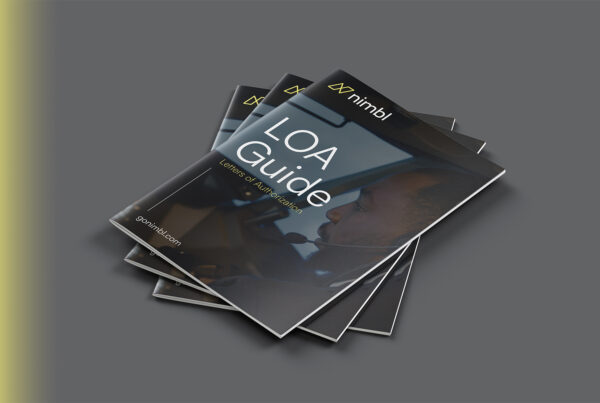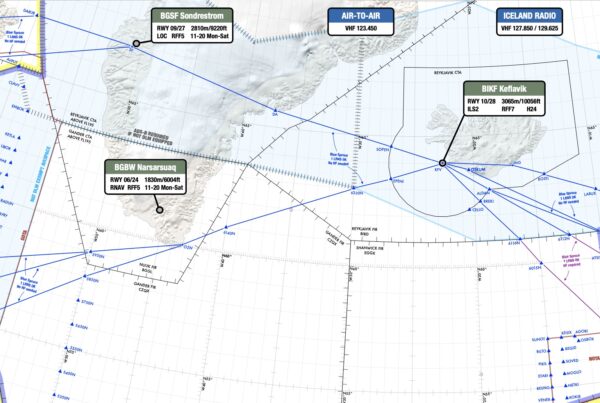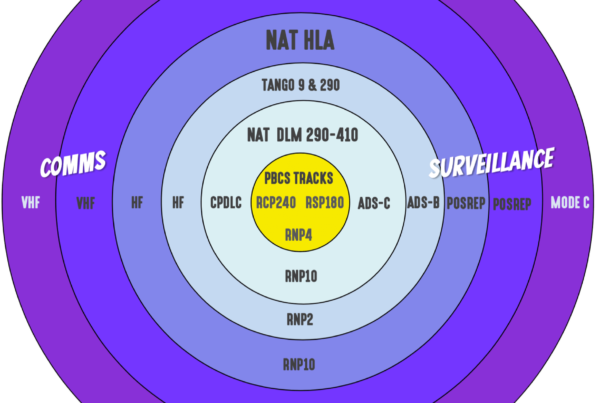All across Europe, ‘Airspace Improvement Events’ are occurring. It sounds huge. We were expecting new regions, routes, maybe some special-filtered cleaner air being puffed out into it…
Alas, we read through all the Airspace Improvement Event notices, and from what we gather, it is part of a big, ongoing project to implement things like Free Route Airspace, more PBN routes, and to basically tidy up the airspace a little. This is not limited to just Europe though – the world is going PBN.
So, less an ‘Event’ and more a ‘Something’?
Everything is moving to Performance Based Navigation. It has something to do with being compliant with EC Regulation 2018/1048, but really just comes down to more efficient, better, safer, increased capacity airspace and approach benefits for everyone.
As simply as possible – VORs are out, Waypoints are in.
In a bit more detail – fixed ATS routes will continue to be implemented for better flow management and lateral separation, you’ll hear more about Free Route Space, and you’ll start seeing more RNP approaches popping up at airports.
So it is actually quite a big change, but one that will be slow to get implemented. Actually, most countries brought in things like RNAV5 routes and SIDs/STARs that use RNAV1 and GNSS instead of old-fashioned, Navaid-based manoeuvrings quite some time ago, so this isn’t something pilots will necessarily notice and there is no Big Date to look out for.
Except for one – December 1 2022 (but we will get to that later).
Why don’t we like conventional Navaids anymore?
Well, old Navaids need a lot of maintenance and they break a lot. Ok, not a lot, but they do potentially double the chance of some sort of issue for an airplane relying on them. Take your bog standard ILS for example – it has ground transmitters and aircraft receivers (and all the bits around them and in between then) and if any one of these conks out then you can’t fly the ILS (quite so well) anymore.
Your GPS approach on the other hand relies on the aircraft system only, which means less to go wrong.*
*Actually satellites can have issues too – GPS Jamming is a big problem and the plan to decommission Navaids is being delayed because of this.
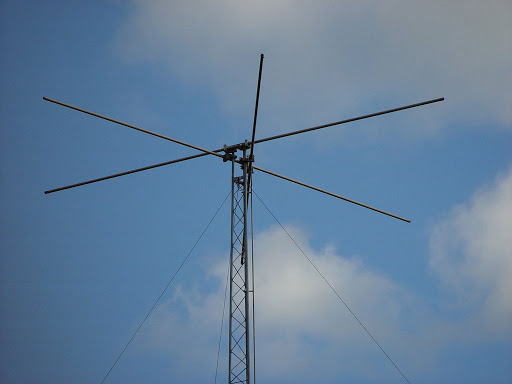
A relic almost as old as Stonehenge
So, what does this all actually mean, practically?
For operators, it doesn’t mean a whole lot. Most aircraft will have been operating to RNAV5 for a fair old while now, so the only noticeable change will probably some newly named waypoints, and some slightly more efficient routings.
You might need to pay a little more attention to any MELs that affect your performance capabilities, and be aware that approaches might no longer have conventional Navaids as backups in the future because a bunch of these are getting decommissioned.
But overall, it really means keeping an eye on them charts to see what’s happening where, and to make sure you pull the right plate out for your arrival.
PBN, Say Again?
So, PBN, again. And December 1 2022. What happens then?
ICAO has ordered all approach charts to reflect the new specifications by December 1, 2022.

This
What is changing?
All charts will say RNP APCH on them (or RNP AR APCH) instead of RNAV, RNP (GNSS) or whatever other random title they currently have. The chart should have the three lines of minima on it which you will need to know – your LNAV, LNAV/VNAV or your LPV.
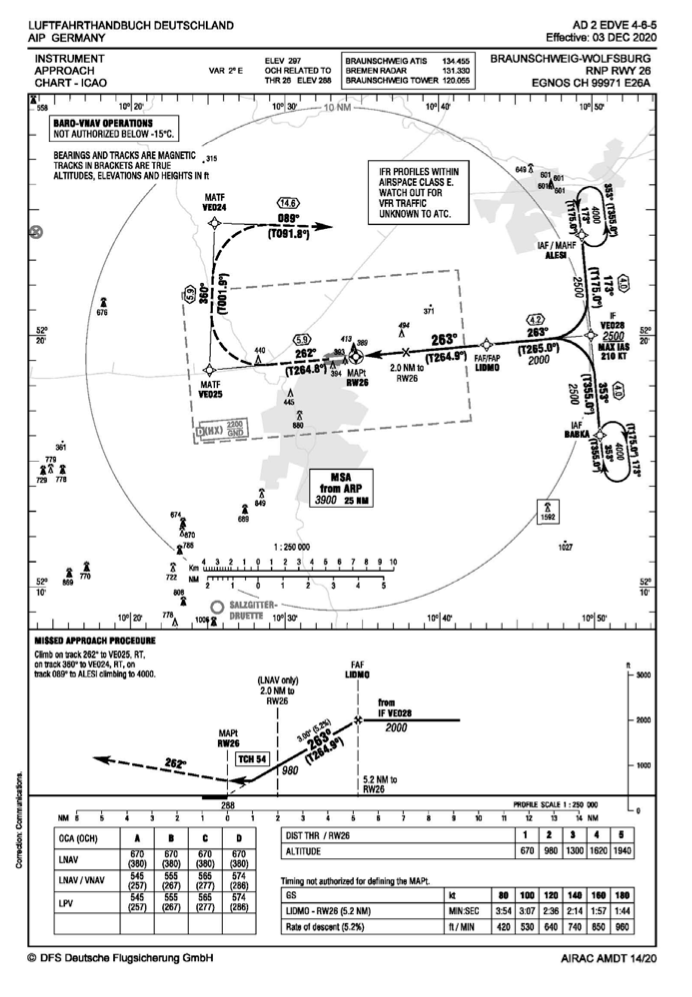
The Chart and the Minimas
Which country is winning the chart race?
ICAO post updates on the implementation which you can follow here, although they last updated it in 2017 so let’s hope it is looking a little better now.
All the R’s
In case you are still lost at RNP instead of RNAV, here is a quick recap on some terms for you:
- GNSS is your Global Navigation Satellite System and it is a generic terms for all satellite navigation systems including GPS, Galileo, GLONASS, and ones augmented by ABAS, SBAS, GBAS… all the BASes.
- LNAV, VNVAV, LPV, LP are your different minimus given on an RNP approach chart.
- PBN is Performance Based Navigation based on performance requirements of the aircraft on a route or approach or in designated airspace.
- RNP is required navigation performance which basically means the onboard monitoring and alerting system your aircraft has.
- RNP Approach is a generic term for any approach which uses GNSS to enable it and an RNP system to fly it.
- RNAV Approach is what RNP approaches used to be called.
- RNP APCH is the name of the navigation specification in the ICAO PBN manual for the 4 types of approach:
- LNAV (GPS NPA)
- LP (SBAS-based NPA)
- LNAV/VNAV (APV Baro-VNAV)
- LPV (APV SBAS or SBAS Cat I)
- RNP AR APCH is an approach the requires a specific aircraft qualification and operational approval. Usually because it takes places in an environment “rich in obstacles”. The AR stands for ‘approval required”. So you might be allowed to fly an RNP (RNAV) but not an RNP AR and your OpSpec (and training) are going to make this pretty clear.
What is Free Route Airspace?
FRA is a specified volume of airspace in which users can freely plan a route between defined entry and exit points. It makes the sector much more efficient.
And because we mentioned it earlier, what about RNAV?
Way back in the olden days (not as far back as when airplanes just had a compass and a map to use, but before GPS came in), there used to be Navaids. Ancient relics called VORs and NDBs which helped pilots work out where they were.
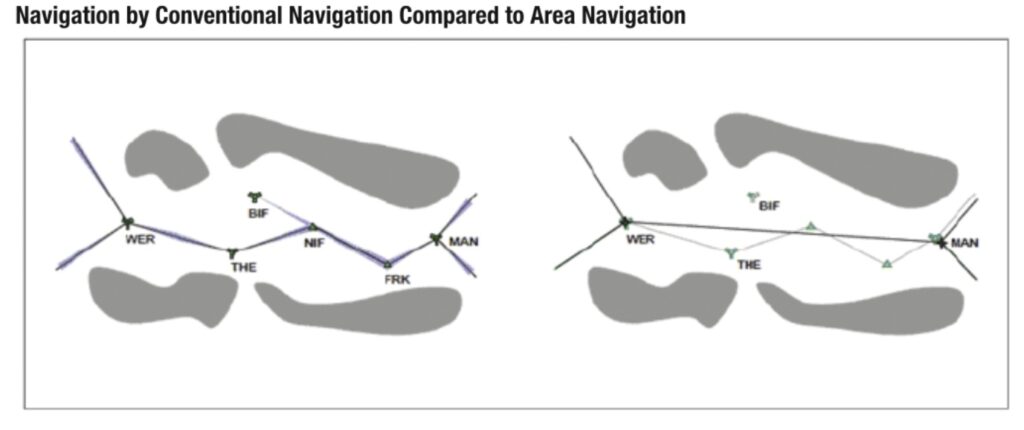
Possibly the least necessary (and most boring) visual explanation of something we’ve ever seen
But then GPS came along and brought with it a way more effective and accurate way to navigate. How accurate is defined by ICAO under their four main navigation specifications – RNAV10, RNAV5, RNAV2 and RNAV1
RNAV5 is actually fairly basic. It has been around in Europe since 1998 and is mandated in pretty much all high level airspace there.
The 5 bit refers to the requirement for aircraft to operate to a minimum navigational accuracy of +/-5nm for 95% of the time.
RNAV1 is your precision RNAV (1 being +/-1nm). RNAV10 is generally what you find over the oceans, and RNAV2 is generally used in en-route areas of the US.
Fun fact: The UAE and Bahrain FIRs implemented RNAV1 a while back, which means you need GPS Primary to route into here. If you’ve encountered GPS jamming en-route, (common in Turkey, Iran, Iraq etc, read all about that here), then this might cause problems for you.
What do you need for RNAV5 operations?
You need some sort of FMS, 1 IRS, 1 GPS or VOR/DME receiver and 2 nav displays.
What about RNP?
If it is an RNP navigation specification then there is also a requirement for on-board performance monitoring and alerting. RNAV refers to ‘area navigation’ and it is slightly different to an RNP system (the monitoring and alerting requirements). PBN requires an RNAV or RNP system, while and RNP APCH specifically requires an RNP system.
What else?
Actually, that’s about it. Except for the poor old UK that will no longer support LPV approaches from June.

In case you were wondering about the accuracy, here is a glorious image to show you
Need to know more?
Here is ICAO EUR Doc 025 which contains all the EUR RNP APCH Guidance Material.
More on the topic:
- More: NAT Crossing after GPS spoofing: a guide
- More: Where is the spoofing today? Two maps to help
- More: Computer Says No: Why FAA RVSM Approvals Matter in Europe
- More: FAA warning issued, further serious navigation failures reported
- More: Flights misled over position, navigation failure follows
More reading:
- Latest: LOA Guide for US Operators
- Latest: NAT Ops: Flying the Blue Spruce Routes
- Latest: NAT Guide 2025 – My First NAT Flight is Tomorrow
- Safe Airspace: Risk Database
- Weekly Ops Bulletin: Subscribe
- Membership plans: Why join OPSGROUP?











 Get the famous weekly
Get the famous weekly 



